Since I am writing all this long after the fact, I have a certain luxury in deciding how I will present things. If I’d written it at the time it would have been chronological, with
 all the units
all the unitsdone in stages (for instance, everyone got their mud smeared on as a group, all in one stage). As it is, I get to go back over the entire process platoon by platoon. This first article is going to be rather long. Perhaps this won’t be the case by the time I get down to the machine gunners.
The first unit I built for this force was, logically, 3rd platoon. Given what I wanted to do with them, it seemed like a decent choice to start with the platoon that I expected would take the most work. They’d be out of the way, and would set the bar for the rest of the army. While it may have made a certain kind of sense to start with 1st platoon, I knew from the beginning that I wanted to model a unit assaulting a German gun position, preferably in some way that all the stands could be put together to form a min-diorama. Based on the roster, it had to be 3rd platoon.
This was the start of my event-shifting. I wanted the theme of Brecourt Manner to be represented in my army, but that fight was in the French summer, not the Belgian Winter, so I was going to have to take some artistic liberties with history. I also realized that I would have to down-size the guns. In real life, the Germans had been servicing a battery of 10.5cm howitzers, but have you ever tried to fit a howitzer on a medium base? It just doesn’t work. In the end, I decided to go with PaK 75 AT guns – the casual observer probably wouldn’t notice, and the seasoned gamer would realize that using the actual guns wouldn’t have worked. Shoot, even if they’d fit, that would have been a lot of scenery to drag around the table. So the guns shrank in the wash. Once someone saw the paratrooper stuffing a potatoe masher down the barrel, they’d know what I was doing.
I also had to accept a certain amount of event-shifting in terms of characters. For instance, the shot in the miniseries involving the grenade and the gun barrel depicted Cpt. Winters doing the deed, but I was obviously going to want to use him for a command element. So in the end I gave this action to Sgt. Taylor, to perform on a down-sized gun, in a different country, at the wrong time of year. But man, it was gonna be cool!
You may have noticed by now that I like to plan things out. In this instance, I needed to envision the entire German gun battery, keeping in mind how I would actually model it, and I needed to come up with a way to cut the scene into small, medium base sized pieces. After a few sketches, I hit on the idea of not depicting the entire battery, which would have required far too much scenery and just wouldn’t have been very interesting, but rather showing just enough of the battery to give that impression. As I started thinking about materials, I remembered these old whicker-siding sort of things I had left over from an old model kit. They look surprising like the German-style woven-stick trench reinforcements. I knew I’d come up with a use for them some day! But, alas, I didn’t have enough to put trenches like that on every stand. I also wanted to put the guns down in pits, but I didn’t want to model a small hill for the entire platoon. I finally hit upon the idea of depicting part of the trench system, as if it were a ring around the gun pit, but not worry about showing every little bit of everything. If a trench line extended further than the edge of a base, I’d just let it.
As the idea got tighter, I needed to see how all the elements would fit together. I’d also need a guide as I started cutting and gluing things. This is what I came up with:
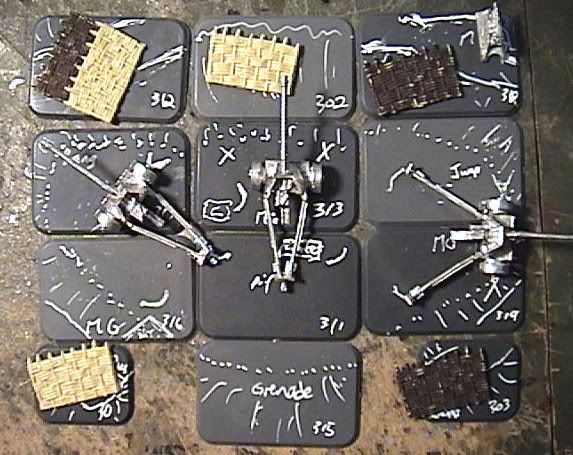
I laid out the empty bases, with some of the scenic pieces I knew I’d be using, and just sketched out the foot print of the battery, including where the guns would go. All the marks were made with a Sharpie poster paint pen so they would just scratch off later with a finger nail. Once I knew more or less how all the pieces were going to fit together, I could start working on individual teams in stages – the first pass would get the basic arrangement and the actual conversion work; the second pass would be with putty to build up the contours, then any fine details would be added, and finally everything would get a coating of my patented mud sauce.
Anyway, enough on the philosophy of modeling, let get out the glue! I actually started with team 312, but since I neglected to take a 1st stage picture of them, we’ll just start with 318.
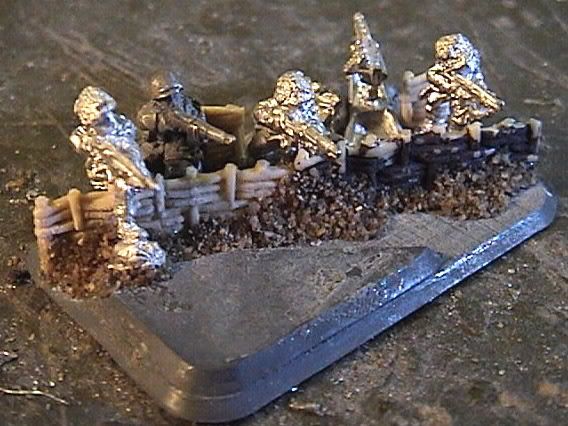
While this was a pretty basic team in terms of figure conversions – which is too bad, that’s probably my favorite part of modeling – it does illustrate my process pretty well. First, all the elements – miniatures, scenic elements, plastic and metal bits, etc. – are arranged on the base as per the plan shown above. Any digging that needs to happen on the plastic base is done first – in this case, I cut a notch into the surface of the base for the plastic wicker bits to slot into. They would still need to be glued, but this would help them stand. A bit of sand was sprinkled along the seam, mostly to form a kind of concrete and strengthen the bond. It also makes the glue dry faster. Rough cut bits of plastic were used to raise up the level along the front. You can also see some of my favorite tricks to help hide the base tab on the figures.
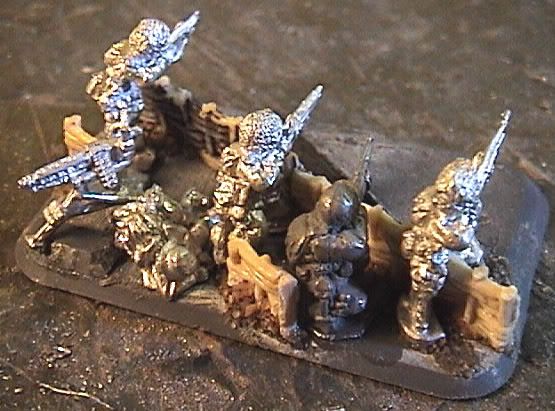
Seriously, I can’t stand to see the base tabs on miniatures, particularly when they are based as teams like they are for Flames of War. I never ever want to see that tab! But something I’ve noticed along the way is that every one assumes it is there. If you can get the finished result to do something that is “obviously impossible,” or at least assumed to be based on things everyone knows and forgets about miniatures, like they all have a base tab, then you can get some impressive results. Going down the line in the picture above from left to right, the first soldier’s tab has been filed down until it was very thin. Actually, most of the time when I go for the “very very thin” base tab, I slice the tab in half horizontally with a razor saw and then file that down, just because it goes more quickly. The German casualty didn’t have much of a base tab; the next American in line simply had his tab cut off with a razor saw – since he was going to be touching the side of the trench, I figured I could glue him to the wall to make up the missing stability. The next, who looks slightly darker than the rest in this picture, also had his base sliced and filed, while the last guy had his tab filed down some, then cut in half vertically and his legs spread slightly with pliers. Now I could position his feet on either side of the trench line for a more dynamic pose.

Once the first stage was completed (not just for this team, but for several platoons) putty was used to bulk out the contours. I used some kind of cheep 2-part epoxy putty for this –actually, the label calls it an epoxy paste, which seems accurate – it is much softer than most epoxy putties, and feels almost like wood filler while workable. I’ll include a brand name in a future post. While some models needed some work at this stage, in this instance it was really just a matter of getting it on the model and smoothing the sides.
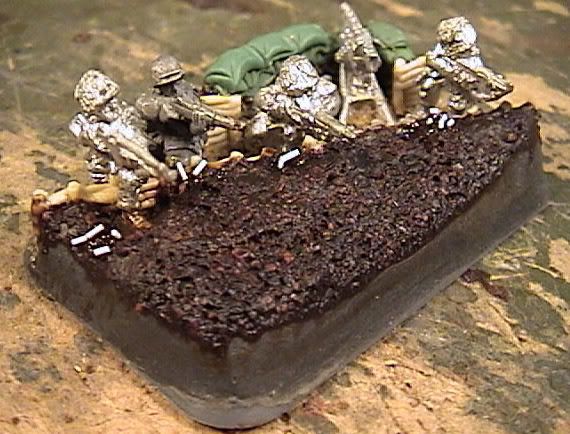
Once the putty had set it was time for the really fun part, the mud coat and final details. The surface texture, my “mud coat,” is a simple mix of white glue, water, and coffee. I like to use home-ground, un-brewed coffee for this, and it actually works best if you mix up a large batch and let it sit for a while, maybe even over night, before you use it. The beauty of this method is the irregular particle size – some of the coffee will still be little chunks, and some will be powder. The powder will completely dissolve in the water/glue mix, only to be deposited evenly over the surface as it dries. Meanwhile, the chunks keep the texture interesting, and sometimes end up painted as small rocks. It is also a joy to apply, because you can just slop it all over everything and clean it up with a wet brush, even off the miniatures themselves.

Somewhere around this time all the final details are added. In this case I used green stuff to model the sand bags around the machine gun – itself a clever way to save limited wicker. A few bits were added like empty ammo boxes and spent ammo made from cut down plastic rod. I love spent brass on the ground. Also notice the sand applied to the bottom of the trench. To better sell the idea that some areas were dug into the ground while other surfaces were not, I wanted to give them distinct textures. I used a simple water/white glue mix brushed onto the base, sprinkled with sand, to create this effect.
Wow, all that for one team. Lets take a look at some other interesting details in this platoon. This sequence shows the same team in the three main stages of construction, and illustrates a few other techniques I would use through out the platoon. The first and most obvious should be what I’ve done to the gun. There was no way to work the full-size AT guns, centered on the bases, with at least four paratroopers and probably a dead German, and maybe some trench works, all on a medium base.
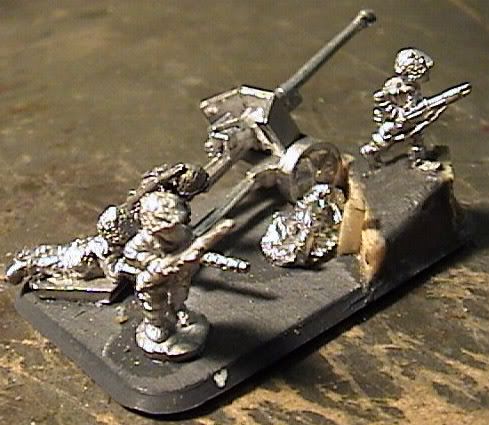
My solution was to cut the gun limbers and put half on each of two bases. If the limber arms extended base a base, I just cut them off and put them on another base. This really let me spread the guns over a far greater number of bases, so that none of the bases were totally over powered by the gun. I think it also helped the bases that otherwise would have been without any significant German bits – by giving them all parts of the guns I could tie the platoon together.

You can also see my old base tab hiding tricks at work. After hacking most of the base tab away with a razor saw and a wire clipper, I used some rough plastic to hold what remains of his base tab up at the correct height and then hid it under sand and putty. The other foot was glued to the edge of the trench.
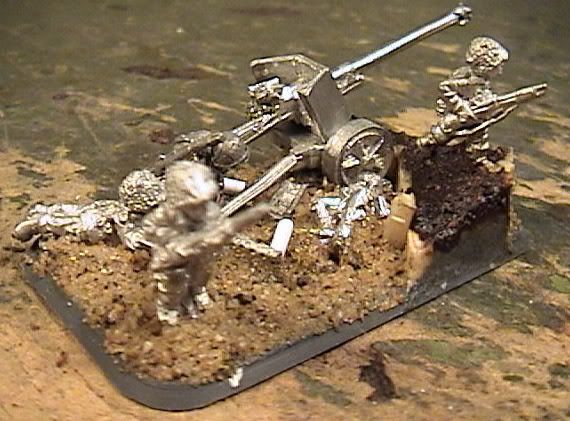
Balsa wood strips were used to make the wooden sides of the gun pit. I’m not 100% sure if that’s more or less historically accurate, but it didn’t matter – I didn’t have enough fake wicker to go around. Much like the coffee and the sand, this also made the gun pit look different than the trenches. Once again, I used sand to make the floor of the gun pit look different from the undisturbed soil, and added various German bits and other flavor – a dead gunner, spent shells for the gun, spent brass for the small arms. A pin vice, knife, and pliers were used to distress the gun and give it the appearance that the paratroopers had disabled it just before the viewer arrived.
Using the same ideas of spreading a single scenic feature over several bases, somewhere along the way I decided to model a command bunker into the gun position. It would look cool, would show off the concentric rings of the gun pit, and would give me some place to have Winters finding the map with “every Krout gun in Normandy.” I even found a little scrap of miniature corrugated aluminum to use as the roof.
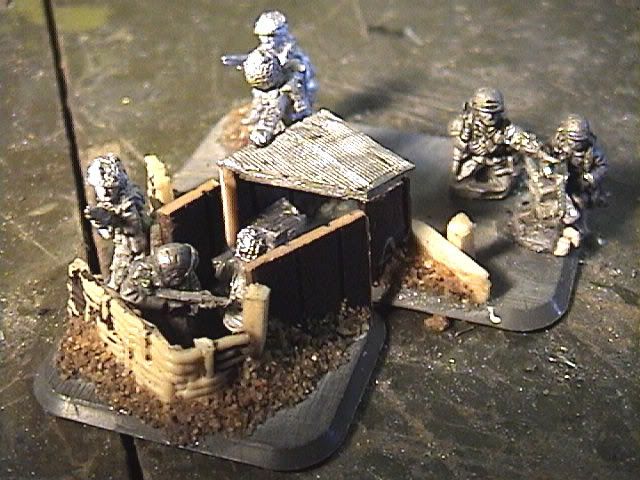
As you can see, I left the roof removable on one of the stands, so that I could get in there and paint the soldier inside the bunker. This is the second instance in this platoon along of a “not-Winters;” I’m giving this action to Lt. Shaymes. On the medium base you can see the feet from one of the guns, extended onto this base. Pretty much all elements of the gun position come together between these two teams, with bits of wicker trench, wooden gun put, and wood-sided bunker all visible together. These followed the same construction pattern as the other teams in this platoon, with some elements actually free-standing before they were backfilled. You can also see that I’ve been up to my old base tab hiding tricks.
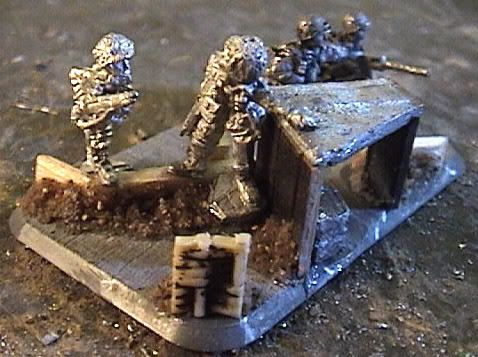
The bunker was detailed with various odds and ends that seemed appropriate. Small bits of foil were used to make loose paperwork. The desk was a pair of ammo cases cast together that I cut in half, one piece for each end of the bunker.
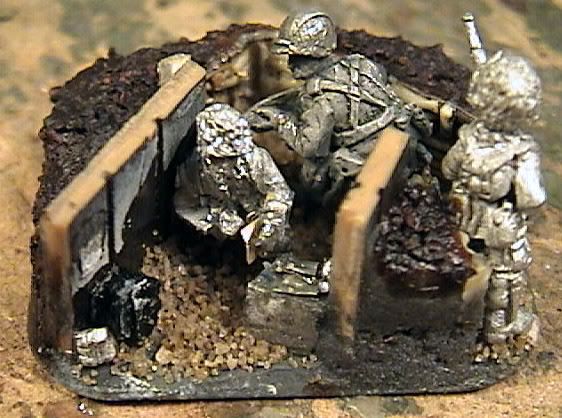
Finally these teams got the same mud treatment as anyone else, with sand on the floor of the trench work. At this point, my process should be getting pretty clear, so I’m just going to use the rest of this post to highlight various “under the hood,” details. Basically, I want to show off all the work I did before I cover it all in paint!
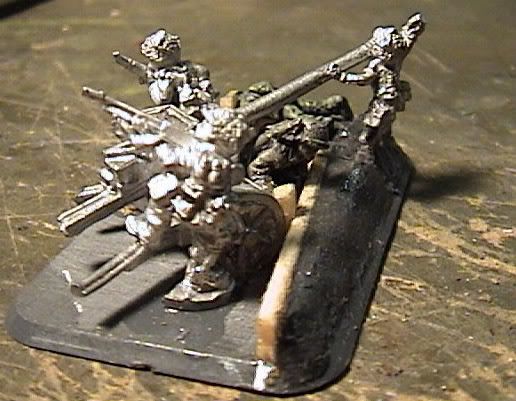

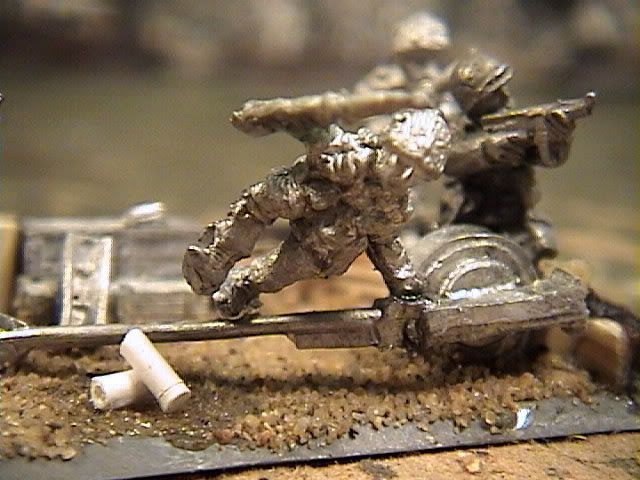
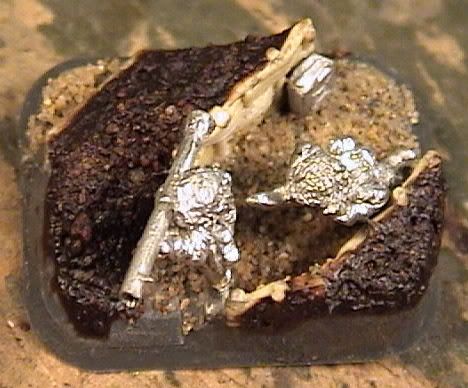
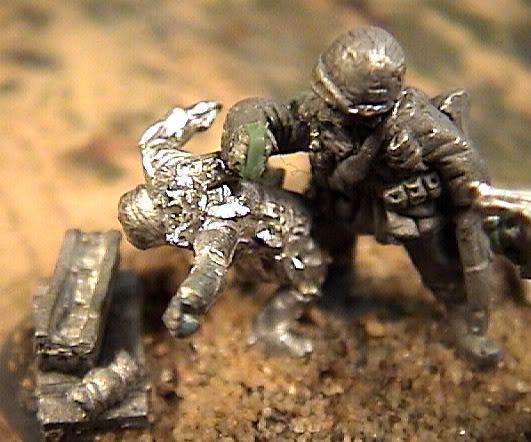
Finally, this is what the platoon looked like all together:

Jesus…. I got how many platoons in this army?

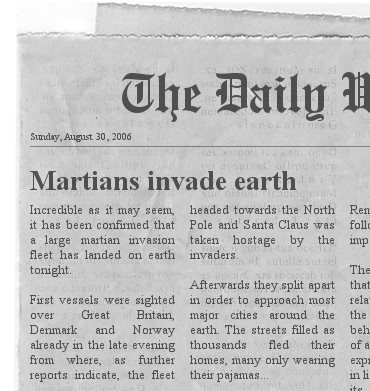
1 comment:
Wow!! Those are incredible!!! Very Very Cool!!!!
Post a Comment